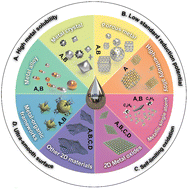Gallium-based liquid metals as reaction media for nanomaterials synthesis
Abstract
Gallium-based liquid metals (LMs) and their alloys have gained prominence in the realm of flexible and stretchable electronics. Recent advances have expanded the interest to explore the electron-rich core and interface of LMs to synthesize various nanomaterials, where Ga-based LMs serve as versatile reaction media. In this paper, we delve into the latest developments within this burgeoning field. Our discussion begins by elucidating the unique attributes of LMs that render them suitable as reaction media, including their high metal solubility, low standard reduction potential, self-limiting oxidation and ultra-smooth and “layer” surface. We then provide a comprehensive categorized summary of utilizing these features to fabricate a variety of nanomaterials, including pure metallic materials (metal alloys, metal crystals, porous metals, high-entropy alloys and metallic single atoms), metal–inorganic compounds (2D metal oxides, 2D metallic inorganic compounds and 2D graphitic materials), as well as metal–organic composites (metal–organic frameworks). This paper concludes by discussing the current challenges in this field and exploring potential future directions. The versatility and unique properties of Ga-based LMs are poised to play a pivotal role in the future of nanomaterial science, paving the way for more efficient, sustainable, and innovative technological solutions.

- This article is part of the themed collections: 2025 Lunar New Year Collection, Recent Review Articles, Nanoscale 2024 Emerging Investigators and Nanoscale Most Popular 2024 Articles


 Please wait while we load your content...
Please wait while we load your content...